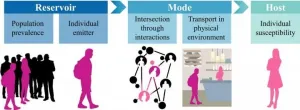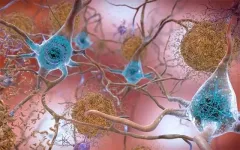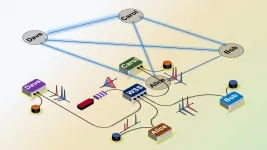(Press-News.org) When you think about your carbon footprint, what comes to mind? Driving and flying, probably. Perhaps home energy consumption or those daily Amazon deliveries. But what about watching Netflix or having Zoom meetings? Ever thought about the carbon footprint of the silicon chips inside your phone, smartwatch or the countless other devices inside your home?
Every aspect of modern computing, from the smallest chip to the largest data center comes with a carbon price tag. For the better part of a century, the tech industry and the field of computation as a whole have focused on building smaller, faster, more powerful devices -- but few have considered their overall environmental impact.
Researchers at the Harvard John A. Paulson School of Engineering and Applied Sciences (SEAS) are trying to change that.
"Over the next decade, the demand, number and types of devices is only going to grow," said Udit Gupta, a PhD candidate in Computer Science at SEAS. "We want to know what impact that will have on the environment and how we, as a field, should be thinking about how we adopt more sustainable practices."
Gupta, along with Gu-Yeon Wei, the Robert and Suzanne Case Professor of Electrical Engineering and Computer Science, and David Brooks, the Haley Family Professor of Computer Science, will present a paper on the environmental footprint of computing at the IEEE International Symposium on High-Performance Computer Architecture on March 3rd, 2021.
The SEAS research is part of a collaboration with Facebook, where Gupta is an intern, and Arizona State University.
The team not only explored every aspect of computing, from chip architecture to data center design, but also mapped the entire lifetime of a device, from manufacturing to recycling, to identify the stages where the most emissions occur.
The team found that most emissions related to modern mobile and data-center equipment come from hardware manufacturing and infrastructure.
"A lot of the focus has been on how we reduce the amount of energy used by computers, but we found that it's also really important to think about the emissions from just building these processors," said Brooks. "If manufacturing is really important to emissions, can we design better processors? Can we reduce the complexity of our devices so that manufacturing emissions are lower?"
Take chip design, for example.
Today's chips are optimized for size, performance and battery life. The typical chip is about 100 square millimeters of silicon and houses billions of transistors. But at any given time, only a portion of that silicon is being used. In fact, if all the transistors were fired up at the same time, the device would exhaust its battery life and overheat. This so-called dark silicon improves a device's performance and battery life but it's wildly inefficient if you consider the carbon footprint that goes into manufacturing the chip.
"You have to ask yourself, what is the carbon impact of that added performance," said Wei. "Dark silicon offers a boost in energy efficiency but what's the cost in terms of manufacturing? Is there a way to design a smaller and smarter chip that uses all of the silicon available? That is a really intricate, interesting, and exciting problem."
The same issues face data centers. Today, data centers, some of which span many millions of square feet, account for 1 percent of global energy consumption, a number that is expected to grow.
As cloud computing continues to grow, decisions about where to run applications -- on a device or in a data center -- are being made based on performance and battery life, not carbon footprint.
"We need to be asking what's greener, running applications on the device or in a data center," said Gupta. "These decisions must optimize for global carbon emissions by taking into account application characteristics, efficiency of each hardware device, and varying power grids over the day."
The researchers are also challenging industry to look at the chemicals used in manufacturing.
Adding environmental impact to the parameters of computational design requires a massive cultural shift in every level of the field, from undergraduate CS students to CEOs.
To that end, Brooks has partnered with Embedded EthiCS, a Harvard program that embeds philosophers directly into computer science courses to teach students how to think through the ethical and social implications of their work. Brooks is including an Embedded EthiCS module on computational sustainability in COMPSCI 146: Computer Architecture this spring.
The researchers also hope to partner with faculty from Environmental Science and Engineering at SEAS and the Harvard University Center for the Environment to explore how to enact change at the policy level.
"The goal of this paper is to raise awareness of the carbon footprint associated with computing and to challenge the field to add carbon footprint to the list of metrics we consider when designing new processes, new computing systems, new hardware, and new ways to use devices. We need this to be a primary objective in the development of computing overall," said Wei.
The paper was co-authored by Sylvia Lee, Jordan Tse, Hsien-Hsin S. Lee and Carole-Jean Wu from Facebook and Young Geun Kim from Arizona State University.
INFORMATION:
Imagine you're driving up a hill toward a traffic light. The light is still green so you're tempted to accelerate to make it through the intersection before the light changes. Then, a device in your car receives a signal from the controller mounted on the intersection alerting you that the light will change in two seconds -- clearly not enough time to beat the light. You take your foot off the gas pedal and decelerate, saving on fuel. You feel safer, too, knowing you didn't run a red light and potentially cause a collision in the intersection.
Connected and automated vehicles, which can interact vehicle to vehicle (V2V) and between vehicles and roadway ...
Type 2 diabetes, once considered an adult disease, is increasingly causing health complications among American youth. A research review published in the Journal of Osteopathic Medicine suggests physicians should work to more aggressively prevent pediatric diabetes.
Because few pediatric Type 2 diabetes treatment options are available, prevention is unusually important. To improve health outcomes, the paper's authors recommend physicians conduct regular screenings of children and adolescents, adopt a high level of suspicion, and intervene early and often with families who have children at risk for prediabetes and T2 diabetes.
"Pediatric type 2 diabetes is more progressive and aggressive than adult-onset Type 2 diabetes," ...
Boulder, Colo., USA: Several articles were published online ahead of print
for GSA Bulletin in February. Topics include earthquake cycles in
southern Cascadia, fault dynamics in the Gulf of Mexico, debris flow after
wildfires, the assembly of Rodinia, and the case for no ring fracture in
Mono basin.
Jurassic evolution of the Qaidam Basin in western China: Constrained by
stratigraphic
succession, detrital zircon U-Pb geochronology and Hf isotope analysis
Tao Qian; Zongxiu Wang; Yu Wang; Shaofeng Liu; Wanli Gao ...
Abstract:
The formation and evolution of an intracontinental basin triggered via the
subduction or collision of plates at continental margins can record
intracontinental tectonic processes. As a typical ...
In the 1995 movie "Outbreak," Dustin Hoffman's character realizes, with appropriately dramatic horror, that an infectious virus is "airborne" because it's found to be spreading through hospital vents.
The issue of whether our real-life pandemic virus, SARS-CoV-2, is "airborne" is predictably more complex. The current body of evidence suggests that COVID-19 primarily spreads through respiratory droplets - the small, liquid particles you sneeze or cough, that travel some distance, and fall to the floor. But consensus is mounting that, under the right circumstances, smaller floating particles called aerosols can carry the virus over longer distances and remain ...
Amyloid plaques are pathological hallmarks of Alzheimer's disease (AD) -- clumps of misfolded proteins that accumulate in the brain, disrupting and killing neurons and resulting in the progressive cognitive impairment that is characteristic of the widespread neurological disorder.
In a new study, published March 2, 2021 in the Journal of Experimental Medicine (JEM), researchers at University of California San Diego School of Medicine, Massachusetts General Hospital and elsewhere have identified a new drug that could prevent AD by modulating, rather than inhibiting, a key enzyme involved ...
WEST LAFAYETTE, Ind. -- When quantum computers become more powerful and widespread, they will need a robust quantum internet to communicate.
Purdue University engineers have addressed an issue barring the development of quantum networks that are big enough to reliably support more than a handful of users.
The method, demonstrated in a paper published in Optica, could help lay the groundwork for when a large number of quantum computers, quantum sensors and other quantum technology are ready to go online and communicate with each other.
The team deployed a programmable switch to adjust how much data goes to each ...
Scientists regularly use remote sensing drones and satellites to record how climate change affects permafrost thaw rates -- methods that work well in barren tundra landscapes where there's nothing to obstruct the view.
But in boreal regions, which harbor a significant portion of the world's permafrost, obscuring vegetation can stymy even the most advanced remote sensing technology.
In a study published in January, researchers in Germany and at the University of Alaska Fairbanks' Geophysical Institute developed a method of using satellite imagery to measure the depth of thaw directly above permafrost in boreal ecosystems. Rather than trying to peer past ...
They can hear well up to about forty years old, but then suddenly deafness strikes people with DFNA9. The cells of the inner ear can no longer reverse the damage caused by a genetic defect in their DNA. Researchers at Radboud university medical center have now developed a "genetic patch" for this type of hereditary deafness, with which they can eliminate the problems in the hearing cells. Further research in animals and humans is needed to bring the genetic patch to the clinic as a therapy.
Hereditary deafness can manifest itself in different ways. Often the hereditary defect (mutation) immediately causes deafness from birth. Sometimes, as with DFNA9, you experience the initial ...
Philadelphia, March 2, 2021--Taking the first deep dive into how the immune system is behaving in patients with multisystem inflammatory syndrome in children (MIS-C), researchers at Children's Hospital of Philadelphia (CHOP) and the Perelman School of Medicine at the University of Pennsylvania have found that children with this condition have highly activated immune systems that, in many ways, are more similar to those of adults with severe COVID-19. The results, published today in Science Immunology, show that better understanding the immune activation in patients with MIS-C could not only help better treat those patients but also improve treatment for adults with ...
A new study of patients with Multisystem Inflammatory Syndrome in Children (MIS-C), a rare but severe complication of COVID-19 in children, reveals distinct immune features of COVID-19 not seen in adults that may clue scientists in to why SARS-CoV-2 infection manifests differently in children compared with adults. Their results showed that although the immune landscape in pediatric COVID-19 was similar to that in adults, MIS-C patients uniquely exhibited increased activation of a blood vessel-patrolling CD8+ killer T cell subset, and all pediatric COVID-19 patients harbored greater B cell frequencies for a more prolonged period of time than observed in healthy adults. MIS-C is characterized by pervasive inflammation, an array of symptoms ranging from fever ...




